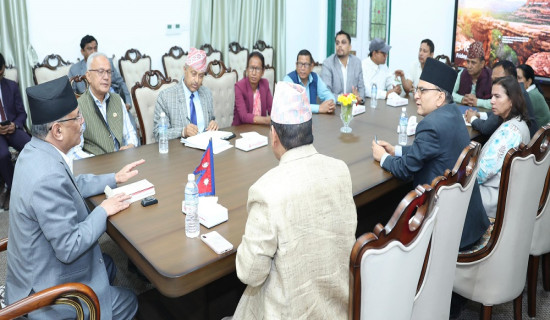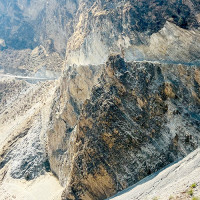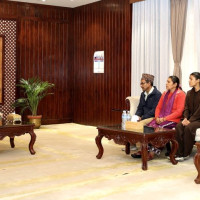- Saturday, 20 April 2024
Paubha Painting: Authenticity To Nepali Art
Nepal is known for its illustrious heritage and abundance of art, which makes Nepal unique across the globe.
Among the various art forms, the traditional Paubha art is one that has played an incomparable role in the preservation and promotion of Nepali art and culture.
Paubha is a traditional art practised notably by the Newa people to illustrate the stories and philosophies of various deities from Hinduism and Buddhism. Paubha art is used for both religious and spiritual purposes. The Newa community makes Paubha paintings for worshipping Gods, to celebrate various festivals and other religious practices.
With time, Paubha art is not only made by Newa people to perform religious practices, but this art form has been spreading Nepali original culture and tradition genuinely to the world.
Many artists make great efforts to preserve and develop Nepali art and culture and among them Raj Prakash Tuladhar is one, who has been continuously making traditional Paubha art for over three decades.
Born in Naradevi, the cultural city of Kathmandu in 1975, Tuladhar immersed into the art from the age of five.
Growing up seeing the sculptures of deities in Naradevi, he became intrigued with art from a very young age. He started making sketches from the age of five and this is how his phenomenal artistic journey began.
Naradevi is the core city area of Kathmandu which is exceptionally rich in diverse cultural heritage and glorious traditional arts dating back to ancient times.
Many consider Naradevi to be a place inhabited only by the Newa community, but Tuladhar believes that Naradevi is a place where people of all castes populate and share harmonious bonds like hundreds of flowers woven together in a garland.
Although he was infatuated with art from the age of five, he professionally started making Paubha art at the age of 16 after passing the SLC (School Leaving Certificate).
Belonging to a business family, no one encouraged him towards art, but being born and grew up in a cultural community like Naradevi, he got the opportunity to observe various cultural practices, astounding crafts adorned in temples, awe-inspiring monuments of various deities, which unknowingly drew him towards art.
He did not have any formal education in art, but he learned Paubha art for two years with veteran artist Prem Man Singh Chitrakar. He made his first painting of Buddha in 1994.
He rose to fame as a traditional Paubha artist when he made the art of Green Tara in 2013. He sold this painting in Thamel for Rs. 1,00,000. The Nepali art collector resold the painting to a Chinese art collector at a handsome profit. Then, a Chinese art collector exhibited this painting in China and the price value of Tuladhar’s same painting reached over Rs. 1 billion in China.
After this painting was greatly appreciated in China, Tuladhar's artistic skills boosted and the demand for his paintings also started to increase.
He became known as the best artist of Paubha at the national and international level.
He shared that it takes him six months to a year to make a painting and he sells his painting generally for Rs.600000 to 10, 00000.
He has made more than 80 paintings in his three-decade-long career.
He made the paintings of deities from both Buddhism and Hinduism. He made paintings of Padmasambhava (born from lotus) who is also known as Guru Rinpoche and also considered as the pioneer of Tantric Buddhism in Tibet.
He also made wrathful deities
like Chandamaharosana, Kal Bhairava, Vajrayogini.
Likewise, he has made paintings of Lord Ganesha, Manjushree, Green Tara, Arya Tara, Yoginis and many more.
Generally, Tuladhar makes paintings using poster colour but he likes to experiment with colours. He is also known for creating paintings using exceptionally unique colour combinations.
Before starting the painting, Tuladhar studies every detail of the God he is going to create and depicts it very gracefully on the canvases.
He doesn't like to exhibit his paintings in groups. He had his solo exhibition at the Museum of Nepali Art (Mona) last year. His paintings are also kept in the popular Robert Beer Museum in the UK and in other countries.
Apart from painting, he is also a meticulous musician. He takes great pleasure in religious activities.
During every ‘Gunla’ festival, he plays ‘Gunla’ Baja (musical instrument) every day for a month. Gunla is a holy month for Newa Buddhists when they recite the scriptures, observe fasts and visit places of worship playing devotional music.
Similarly, he is associated with Naradevi temple, and the annual dance ‘Pahachare’ is held in Naradevi temple once a year before the ‘Godejatra’ festival in which Tuladhar plays music.
"Paubha painting is the essence of my country Nepal, it is my originality, it is my Karma and the religion that defines my country,” he said.
Every painting is good, but I like my traditional Paubha painting because it is the soil of Nepal,” he added.
Stating his long experience in art, he said that foreigners are exceptionally capable in all forms of art as they have studied art since elementary school. Their government also considers art and artists as the pride and assertions of their country and supports accordingly. That's why foreigners prefer to see original art that reflects Nepali culture rather than foreign art made by Nepali people. He argued that our education system imitates western culture because our education teaches us to send students abroad.
“Now we are following the western culture very passionately, but Westerners are following our Sanskrit language and Eastern culture.”
He opined that in the coming decades, Westerners will also follow Eastern culture just as we are following their culture now. Foreigners love Nepal as the country where Lord Gautam Buddha was born, a country full of religious culture and a place where great energies dwell. He said that although Nepal is a country of religion and spiritualism, Western culture has a great influence on everything including Nepali art culture and lifestyle.
Art is a means of introducing culture without any language. In other countries, the value of art has reached a height, but in Nepal, due to various political issues, the government has not been able to give great value to Nepali traditional art and artists.
Thanka and Paubha paintings come together but he expressed his dissatisfaction that the artists of Thanka paintings are not treated as artists in Nepal.
“Many traders have become rich by selling Thanka paintings made by Nepali artists but unfortunately people do not consider them as artists instead they treat them as wage workers. Being an artist, it hurts to see an artist being disrespected.”
Tuladhar said that Thanka paintings are sold at a high price, but here in Nepal, real artists are not treated as artists.
He is currently making a Chakrasamvar painting which takes about a year to complete. Chakrasamvara is a tantric practice under Vajrayana tantra since time immemorial in Kathmandu and Patan. It is worshipped secretly by Shakya, Bajracharya and Tuladhar caste people of Newa community.
Recently, he got first place in the "Purna Man Shakya Memorial Award’. He has already won several awards and honours for his outstanding contribution in promoting traditional art nationally and internationally.
(Renuka is a journalist at TRN who writes on art, culture and entertainment.)
How did you feel after reading this news?








-square-thumb.jpg)








